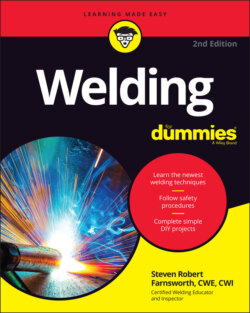Читать книгу Welding For Dummies - Steven Robert Farnsworth - Страница 30
Getting a handle on forms of steel
ОглавлениеSteel is manufactured in many different forms, and each form has its own use for welding projects. Here are a few of the more common forms that you’re likely to run into as you weld:
Flat steel is exactly what it sounds like — a flat piece of steel. It’s also called sheet steel. It comes in a range of thicknesses and sizes, but when it’s larger than 12 inches wide, it’s called plate steel.
Steel bars are made in an array of shapes, but the most common are round, square, or flat. You can see some examples of steel bar shapes in Figure 2-1.FIGURE 2-1: Square (a), flat (b), and round (c) steel bar shapes.
Rolled steel comes in two forms.Hot rolled steel is made to its finished size while the steel is still red hot. Iron oxide forms on the hot steel after it’s rolled. It’s a grayish-black coating that helps protect the steel from rusting. Hot rolled steel is used for piping, tubing, tanks, and other products.Cold rolled steel is made by rolling the steel to its finished size after it’s cooled to room temperature. It doesn’t get the iron oxide that hot rolled steel gets, so cold rolled steel is smooth and bright looking. It’s used for making things like nails and screws.
Like all other metals, steel goes through some changes when you apply the high levels of heat to it that are necessary for welding. The steel around the weld area is subject to distortion and cracking due to the expansion and contraction caused by all that heating and cooling. The good news is that the electrodes and filler metals you use when welding steel are designed to be just as strong (or even stronger) than the metal you’re welding, as long as you let the weld cool off on its own after you’re done welding.
